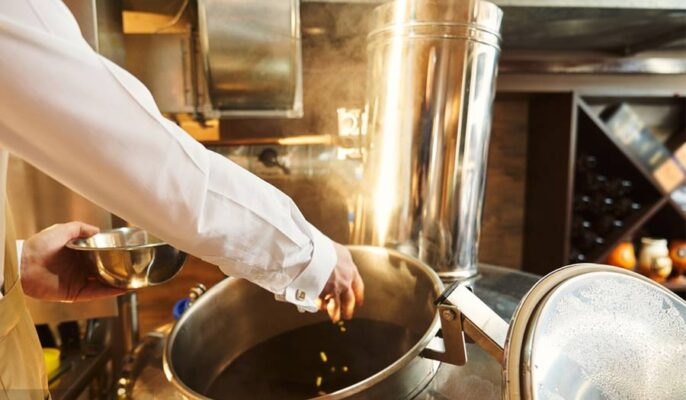In the ever-evolving beer brewing industry, the pursuit of sophistication and innovation is a long journey. Whether for an enthusiastic novice brewer or a seasoned veteran, the key to high-quality beer is mastery of the brewing process. By taking the necessary steps and care during the brewing and fermentation process, it is possible to brew commercial-quality beer at home. The reason commercial beers are so consistent and high-quality is because they control every step of the process. There are many ways to improve your brewery, and increasing your industry knowledge will make you feel better about yourself and produce the highest quality beverages possible.
Professional beer brewing equipment?
With the development of technology, machinery and equipment are also developing. Professional beer brewing equipment refers to the advanced machinery and tools used to produce beer on a large scale. Unlike the smaller kits you might buy for home brewing, these professional setups are designed to optimize the brewing process for greater efficiency, consistency, and scale.
Typical setup includes:
- Mash tun: Where grains are soaked and converted into sugar.
- Fermentation barrel: Where yeast converts sugar into alcohol.
- Cooling systems: These systems help regulate the temperature during fermentation.
- Filtration systems: They ensure transparency and purity of the final product.
- Storage tank: used to store beer before bottling or kegging.
Equipment selection may vary based on the scale of production, the specific beer being produced, and the brewer’s preferences. With the rise of craft beer and microbreweries, the variety of equipment available has exploded to accommodate different brewing philosophies and techniques.
Key Points to Brewing Process Consistency
- Continuous crushing of grains
- Continue to mash
- Water chemical balance
- Continuous spraying
- Cool wort
- Use the same type of fermentation tank and control the temperature
- Transfer beer between containers
Ways to improve your brewing process
A selection of fresh ingredients for brewing
From the choice of malt variety and hop characteristics, to the choice of yeast. Each ingredient plays an important role in shaping the flavor, aroma and character of the final product. By sourcing premium ingredients and conducting rigorous quality assessments, brewers can ensure that each batch of beer is crafted with the highest quality ingredients, laying the foundation for a exceptional beer.
An unpleasant cheesy flavor can develop in old, stored hops, while musty, grassy, and sometimes even moldy or metallic flavors can develop in old, unrefrigerated grains and sometimes extracts.
Using old yeast increases the risk of stalled fermentation, leaving you with a sugary, sweet malt beverage, and gives other bacteria a chance to take over and add horrible off-flavors to your precious homebrew.
Fermentation temperature control
When novice winemakers are starting out, it’s easy to overlook the importance of the fermentation stage. Fermentation is the process by which yeast consumes maltose and produces roughly equal amounts of carbon dioxide and alcohol. Thus, if the fermentation temperature is too high for the yeast strain you are using, you may develop strange flavors in your beer.
When the fermentation temperature is too low, yeast reproduction slows down, beer quality decreases, and the risk of bacterial contamination increases. Keep in mind that different yeast strains have different optimal fermentation temperatures, and if possible, ferment your beer in a temperature-controlled environment.
From mashing and filtration to fermentation and conditioning, close monitoring and regulating temperature at each stage is critical to promoting optimal enzyme activity, yeast vitality and flavor development.
Sanitation status
Strict sanitation and hygiene protocols are an important aspect of ensuring the integrity and quality of the brewing process. By adhering to a strict cleaning regimen for brewing equipment, fermenters and storage vessels, brewers can reduce the risk of contamination and odor caused by harmful microorganisms. Breweries are diligent about cleaning and sanitizing equipment, and there’s nothing worse than wasting a lot of time dealing with spoiled batches due to improper cleaning techniques.
Stainless steel components and equipment are an excellent investment for any brewery because they provide superior sanitation. Further ensuring compliance with food and drink safety rules. But, good hygiene measures should be established and followed daily. For example, to better manage wastewater and reduce water consumption, sanitary drainage systems should be installed in every part of the brewery.
Use a yeast starter
Underdosing yeast or adding inactive yeast is a common mistake among amateur brewers, resulting in beer that is underfermented, stopped, or tastes unpleasant. By making a sourdough starter you can increase the number of yeast cells and test the viability of the yeast. If you don’t have time to make a sourdough starter but must use dry yeast, at least add moisture.
Wort aeration
Yeast need oxygen to do their job. The more oxygen there is in the wort, the better the fermentation will be. Brewing beer with cooled wort exposed to air and oxygen is a great way to enhance flavor and aroma. But, once the fermenter is sealed with an airlock, the yeast no longer has as much fresh air to multiply .
Perform water treatment
Beer is water, and water is the cheapest ingredient by weight, so it makes sense to use high-quality water when brewing. If you brew from over-chlorinated tap water, you may have medicinal flavor ingredients and chlorophenol chemicals added to your beer. If your tap water doesn’t do the trick, you can use RO (reverse osmosis) or distilled water and build a water profile from scratch using brewing salts. It’s an advanced brewing practice, but it does give commercial beers their signature flavor. Brewing salts such as gypsum and calcium chloride help enhance the malt and hop characteristics of a specific style.

Don’t oxidize your beer
Oxygen is a great thing to have when aerating the wort before throwing in the yeast. But beyond that, it can ruin the flavor of your home brew. Hot side aeration can occur if you aerate the wort before it cools to 80 degrees Fahrenheit. When storing or transporting home brew, be careful not to spill or bubble the beer as this can introduce oxygen into the beer. After filling the keg with beer, a best practice is to release any trapped air in the head area by injecting carbon dioxide.
Don’t be in a hurry to drink beer
When pouring beer, it’s easy to rush through the steps because you’re in a rush to drink it. , trying to save a little time often comes at a cost. Brewing beer takes a lot of time. Don’t try to save time by shortening the recommended 60 to 90 minute boil time, letting fermentation temperatures rise too , stopping the fermentation process too , or skipping the bottle or keg conditioning step.
Brewing Don’ts
To avoid popcorn butterbeer flavor, wait at least a week after primary fermentation begins before removing the yeast (diacetyl) from the beer. Don’t use anything but a brown bottle, and if you must use another color, store the beer in a dark place to avoid “skunks.” If you bottle your beer before fermentation is complete, you run the risk of drinking a malty beer, a sugary beer, or even a bottle bomb. To avoid your homebrew tasting too much like fruit and rubbing alcohol, you shouldn’t ferment it at a temperature higher than your yeast’s optimal fermentation temperature.





